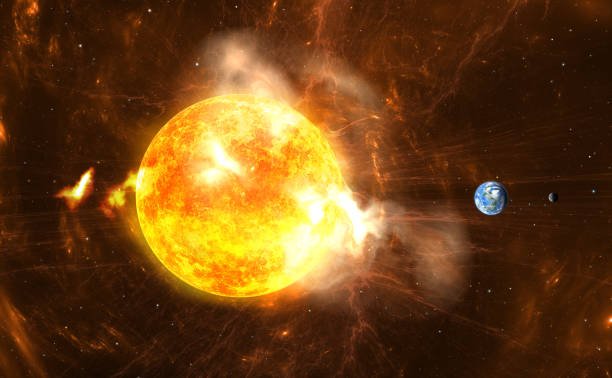At the heart of our solar system burns a seething star, so bright that no eye can stare into its blazing face for long. From ninety-three million miles away, it seems almost gentle—a warm, yellow beacon rising and setting each day, its presence as predictable as breath. Yet beneath that golden light, the Sun is anything but tranquil. It seethes, it broils, it erupts in tantrums so ferocious that even across the vacuum of space, its fury can lash our fragile world.
These outbursts are solar flares, violent flashes of radiation, and their colossal companions—coronal mass ejections, or CMEs. Together, they hurl storms of charged particles toward Earth. Invisible tempests, they ride on solar winds, sometimes arriving like whispers, sometimes crashing into our magnetic shield like cosmic battering rams.
And now, in a world lit and linked by fiber optics and satellites, one question is surfacing with rising urgency: Could a solar flare knock out the Internet?
It’s a question that hovers at the intersection of cosmic wonder and modern dread. It’s not only about physics—it’s about civilization itself. For we live in an age whose pulse runs through cables, signals, data packets, and constant connectivity. What happens if that pulse goes silent?
The Day the Sky Caught Fire
To glimpse the stakes, we must turn the calendar back to a sweltering summer night in 1859. In London, people were jolted awake by a sky ablaze with flickering lights. Blood-red curtains of aurora rippled overhead. Telegraph operators recoiled from their instruments as sparks leapt from the wires, setting paper ablaze. In some places, telegraph systems continued transmitting even after batteries were disconnected, powered solely by the energy coursing through Earth’s geomagnetic field.
This was the Carrington Event—the most intense geomagnetic storm in recorded history. It began on September 1, 1859, when British astronomer Richard Carrington observed an immense white-light flare bursting from the Sun’s surface. Just hours later, Earth was enveloped in a cosmic storm so potent that auroras glowed as far south as Cuba and Jamaica.
Back then, humanity’s technology was primitive. Telegraph wires hummed and sparked, but the world did not collapse. No power grids existed to fail. No satellites circled the globe. No Internet bound continents together in an invisible web.
Yet imagine if a storm of similar magnitude struck today.
Wired Planet, Solar Peril
Since the dawn of the Internet age, we’ve become a civilization of code and signals. An invisible river of data flows constantly around our globe—emails, transactions, cloud storage, streaming videos, banking networks, airline reservations, traffic lights, hospital systems, and military communications. It all pulses through a hidden infrastructure—fiber-optic cables stretching across oceans, satellites orbiting overhead, massive data centers humming in distant cities.
And the Sun watches.
Solar flares and CMEs are not rare curiosities. They are constant features of the solar cycle, an approximately eleven-year ebb and flow of the Sun’s magnetic activity. During solar maximum, sunspots proliferate and magnetic fields twist and snap, flinging plasma into space. Most of these storms miss Earth or strike with glancing blows, causing only spectacular auroras.
But every so often, the Sun aims a cosmic bullet directly at us.
When a CME reaches Earth, it slams into the magnetosphere, compressing it like a squeezed balloon. Energetic particles penetrate the upper atmosphere, inducing electric currents in the ground and in anything that acts as a long conductor—power lines, pipelines, undersea cables. The result is geomagnetically induced currents, or GICs, capable of burning out transformers, short-circuiting equipment, and disrupting sensitive electronics.
Our global dependence on digital technology has made us more vulnerable than any civilization in history.
Not Just Satellites
Popular imagination often focuses on satellites—and indeed, satellites are at high risk. Solar storms can fry electronic components, corrupt signals, degrade GPS accuracy, and damage solar panels. The 2003 Halloween storms, for example, knocked out parts of the Swedish power grid, disrupted satellites, and forced airlines to reroute flights over the poles.
But for the Internet, the greater peril lies closer to home—beneath our oceans and cities.
Consider the undersea cables that connect continents. These cables carry over 95% of international Internet traffic. Contrary to popular belief, these cables do not transmit signals via electricity. Instead, they use pulses of laser light through optical fibers, immune to electromagnetic interference. But the cables require periodic repeaters—electronic amplifiers spaced roughly every 50 to 100 kilometers—to boost the light signals. Those repeaters draw power through metallic conductors running alongside the fiber.
A strong geomagnetic storm can induce electric currents in those conductors, potentially frying the repeaters or triggering cascading failures. A CME powerful enough to damage multiple undersea cable systems could fracture the backbone of the global Internet, severing continents from one another.
Terrestrial power grids face similar risks. High-voltage transformers, essential for transmitting electricity over long distances, can overheat and melt under the onslaught of geomagnetically induced currents. A widespread grid failure would kill Internet access even before cables fail, as data centers and routers go dark without power.
The Internet Apocalypse Scenario
Scientists have modeled the consequences of a Carrington-scale solar storm hitting today’s world. One of the most comprehensive studies comes from Dr. Sangeetha Abdu Jyothi of the University of California, Irvine. In a 2021 paper, she warned that a severe geomagnetic storm could cause “large-scale Internet outages covering entire continents.”
Regional Internet traffic within continents might survive—because local fiber connections are shorter and less susceptible to GICs. But intercontinental links could fail. The result would be a world split into isolated digital islands, unable to communicate.
Consider the consequences:
- Financial chaos as banks lose the ability to execute international transfers.
- Disruption of global supply chains as shipping companies lose contact across oceans.
- Widespread confusion and panic fueled by rumors and misinformation.
- Impacts on aviation, military operations, satellite communication, and GPS navigation.
- Hospitals struggling as cloud-based medical records become inaccessible.
It’s not a doomsday scenario in the Hollywood sense—people wouldn’t be vaporized by solar radiation—but the economic and societal cost could be staggering. A 2013 report by Lloyd’s of London estimated that a Carrington-level storm could inflict $2.6 trillion in damages globally, with recovery times ranging from weeks to years.
The 2012 Near Miss
In July 2012, Earth dodged a solar bullet. On July 23, the Sun unleashed a massive CME, hurling billions of tons of plasma outward at over 2,000 kilometers per second. If the storm had erupted a week earlier, Earth would have been directly in its path.
NASA’s STEREO-A spacecraft captured data from the blast. Researchers later concluded it was comparable to the Carrington Event—a storm strong enough to potentially cripple modern technology. Daniel Baker of the University of Colorado warned that if it had struck Earth, “we would still be picking up the pieces.”
We survived that day only because the Sun’s rotational timing spared us. It was a cosmic coin toss with civilization as the stakes.
Signals in the Sky
The idea that a solar flare could bring our digital world crashing down feels almost mythical—a story from science fiction. Yet history whispers warnings in auroral lights.
In March 1989, a moderate geomagnetic storm blacked out the entire province of Quebec, leaving millions in darkness for nine hours. The storm damaged transformers as far south as New Jersey. Aurora flickered over Texas and Florida. Engineers and scientists realized, with a cold chill, how fragile the grid had become.
Since then, new monitoring systems have improved our ability to forecast solar storms. NASA’s Solar Dynamics Observatory and the ESA’s Solar and Heliospheric Observatory keep watch on the Sun’s restless surface. When an eruption is spotted, space weather agencies issue alerts. Operators can reroute flights, power companies can adjust grid loads, satellite controllers can power down sensitive systems.
But the warning time is short. CMEs can take anywhere from 15 hours to several days to reach Earth. A Carrington-class CME might arrive in as little as 17 hours, leaving precious little time to prepare.
Sunspot Seasons and the Next Peak
As of the mid-2020s, we are entering Solar Cycle 25. The Sun’s activity is rising toward a predicted peak around 2025. Sunspot numbers are increasing faster than scientists initially expected, raising concerns about the likelihood of major solar storms.
It’s a cosmic game of roulette. The odds of a Carrington-scale event striking Earth in any given decade have been estimated at around 12%. That sounds low—until you consider the stakes. The longer we go, the closer we drift to the law of averages catching up.
The Sun does not care about our digital dreams. It has roared and flared for 4.6 billion years, indifferent to the creatures orbiting its blaze. Our global civilization is barely a blink in solar time.
A Civilization with No Backup
Unlike storms or earthquakes, a solar superstorm is not localized. It is planetary. It doesn’t matter if you live in New York or Nairobi, Mumbai or Moscow—if the global backbone fractures, the Internet as we know it goes silent.
Ironically, in our quest to connect the world, we have built a system with shockingly few redundancies. We depend on a limited number of undersea cable routes, power grids linked across vast territories, and satellites vulnerable to high-energy particles.
Some nations are discussing ways to harden their infrastructure—installing protective devices called series capacitors in power grids, shielding transformers, developing geomagnetic storm protocols. But costs are high, and public awareness is low. Solar storms don’t capture the political imagination the way pandemics or wars do.
Meanwhile, the digital economy accelerates. Cloud computing. 5G. Smart homes. Self-driving cars. Each advancement deepens our reliance on uninterrupted data flows. The stakes climb higher.
Human Stories Behind the Science
Beneath the equations and magnetic field plots lies a human story. It’s the story of the engineer in a power station, scanning readouts as needles spike into the red. The satellite operator in Houston, watching helplessly as solar radiation batters electronics 22,000 miles above Earth. The transatlantic trader, staring at a dead Bloomberg terminal while billions of dollars hang in limbo.
It’s the story of a surgeon in an operating room as cloud-based records vanish mid-procedure. Of families separated by oceans, suddenly unable to speak. Of newsrooms racing to learn whether the outage is solar chaos—or a cyberattack.
Solar flares are beautiful—ethereal arcs of plasma, filmed in shimmering ultraviolet by solar observatories. But in their unseen waves, they carry a power that can reach across the vacuum and remind us how delicately balanced our civilization truly is.
The Internet’s Invisible Pulse
It’s easy to take the Internet for granted. Each time we tap a phone screen, a flurry of invisible signals courses through fiber-optic threads under the sea, bounces off satellites, and races through glass and copper. It’s almost magical.
Yet it is not immune to nature’s fury. In the same way earthquakes topple skyscrapers or hurricanes submerge cities, the Sun can unleash storms that ripple through the invisible circuits binding our world together.
We have grown so used to the idea that information flows at the speed of light, without interruption, that we’ve forgotten it rests upon delicate, physical things. Transformers. Repeaters. Routers. Submarine cables. Solar storms remind us that even digital civilization has bones that can break.
A Glimpse of the Day the Net Goes Dark
Imagine the sunrise after a Carrington-class storm:
Across the United States, the power grid groans under induced currents. In some places, transformers smoke and spark. Rolling blackouts ripple outward from city centers.
In Europe, financial exchanges cannot connect to Wall Street. International banking freezes. Ports shut down, unable to process digital bills of lading. Cargo containers pile up on docks. Airlines cancel flights across the Atlantic.
News outlets go dark, starved of updates from foreign bureaus. Social media silences. Text messages bounce back as undeliverable. Rumors race through communities, fueled by uncertainty. Was it hackers? An attack? A natural disaster? People queue at banks to withdraw cash, unsure how long electronic payments will work.
In data centers, servers flicker off as batteries drain. Cloud storage evaporates into silence. Hospitals shift to paper records. Satellite phones remain the only link between continents.
By evening, auroras shimmer over skies as far south as Florida and Madrid. The heavens blaze red and green and purple—a cosmic performance for a world stumbling into digital darkness.
Such a scenario is not inevitable. But neither is it impossible.
Shields and Solutions
The first defense is vigilance. Space weather agencies continuously monitor the Sun, issuing alerts of solar flares and approaching CMEs. Early warning allows grid operators to reduce load, shut down vulnerable transformers, and reroute power.
Engineers are exploring ways to shield undersea cables from geomagnetically induced currents—through improved grounding techniques or non-conductive cable designs. Satellite manufacturers harden spacecraft with radiation shielding and redundant circuits.
But the costs are enormous. Many governments struggle to justify billions of dollars to prepare for a storm that might not strike for decades. It is the ancient problem of defending against rare catastrophes—when budgets and politics prioritize immediate needs.
Some researchers propose decentralized Internet systems that could function locally even if global connections are severed. Mesh networks, local data caches, and community wireless projects could preserve basic connectivity in emergencies.
Ultimately, awareness is key. Solar storms may be rare, but they are inevitable. Humanity cannot turn off the Sun.
The Sun’s Ancient Lessons
Long before humanity built the Internet, ancient civilizations gazed skyward in awe. The Chinese chronicled mysterious “red vapors” in the heavens. Medieval monks recorded nights when the sky glowed bright enough to read by. The Sun has always whispered its warnings in auroral light.
Now, we possess the knowledge to understand those cosmic messages. We have telescopes watching the Sun’s every convulsion. We can measure the magnetic storms racing toward Earth.
But we also stand at a dangerous crossroads—a civilization built on invisible currents, vulnerable to the invisible storms that once merely painted the sky in colors.
The Sun is not our enemy. It is the engine of life, the light of our days, the furnace that forged the elements in our bodies. Yet it is also a reminder that nature holds forces beyond our control. We are creatures of silicon and code, but we remain children of the cosmos.
The Final Question
So—could a solar flare knock out the Internet?
The answer, soberingly, is yes. Not in the blink of an eye, perhaps—not as a single flare instantly vaporizing all connections—but through the chain reaction of a massive geomagnetic storm. A storm like the Carrington Event could fry transformers, corrupt signals, sever cables, and plunge continents into a communication void.
It would not be the end of civilization. But it could be a wound deep enough to scar our economies, disrupt our societies, and force us to reckon with how precarious our digital lives have become.
And it would remind us that while we surf the web and share TikToks, a restless star still rules the sky—a star whose heart beats with storms that could, one day, silence the Internet’s invisible hum.
The Sun, after all, does not play favorites. Its storms care nothing for our technologies, our markets, or our hashtags. It simply burns, and in its fire, the fate of our wired world waits.






